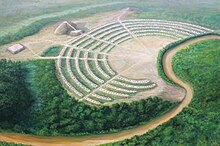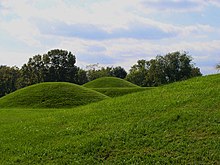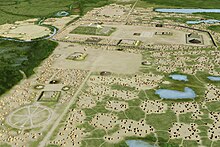Mound

As Mound artificially created hills are mainly in the southeast of the United States referred to were of different Indian cultures to cultural and burial purposes built. The forerunners of the temple and palace pyramids of Mesoamerica are also referred to by research as mounds .
Occurrence
North America
Very often Mounds of the valleys Mississippi to find and its tributaries, the entire course of the Ohio River and the lower reaches of the Missouri , in the areas adjacent to the Susquehanna River and the Wyoming River , in the west of the Alleghany Mountains nearby Virginia and from Lake Ontario to to the St. Lawrence River . They also extend north through Wisconsin and the Rainy River to northern Canadian Ontario and south into the plains of Georgia .
The most important center of these mounds was in what is now Ohio , where more than 10,000 such mounds and more than 1,500 ring walls are counted. The southeastern part of the state of Missouri is also rich in mounds, such as the border area between Iowa and Illinois , where more than 2500 mounds are counted on an area of 128 km². Southern Wisconsin is characterized by the special shape of the Effigy Mounds , with figural ( English effigy ) shapes that represent mammals, birds, reptiles and isolated human figures.

There are also numerous mounds further south in the area of the Mississippi tributaries Yazoo River , Arkansas River and Red River . The mounds in South Carolina and Georgia, as well as Texas, have a slightly different shape and are of more recent origin, like the Cuecillos (Cu) in Mexico . One of the most famous of these systems of early Indian cultures is the Great Serpent Mound . The builders of the approximately 100,000 preserved earthworks in the southeastern United States were initially simply called " Moundbuilders " before research into their structures and artefacts made it possible to distinguish between a multitude of individual phases and cultures.
Sometimes the shell middens, built in parallel in the early days, are called mounds or shell mounds from huge heaps of mussel shells and snail shells from the Ohio River to the coast of the Gulf of Mexico , as well as the southern Atlantic coast . Their origin is even less clear than that of the earth mounds and it is considered possible that their creation was not started according to plan, but that they emerged from the accumulation of remains of the food preparation before they were systematically increased. Therefore, they should not be linguistically linked to the planned mounds.
Central America
In Mesoamerica, the early earth pyramids of the Olmecs ( La Venta , Tres Zapotes , San Lorenzo ) and the Mokaya culture in the area of the former province of Soconusco are known as mounds . From around 100 BC The earth mounds were more and more replaced by stone buildings, whereby - due to the tradition of overbuilding - some of the original earth mounds were preserved as part of the substructure.
development




Mounds first emerged in the middle archaic period between 3500 and 3000 BC. In the area of the lower Mississippi River . Systems made up of individual mounds and those made up of several were built during this time by hunter, gatherer and fisherman cultures who stayed in favorable locations almost all year round. The mounds were almost exclusively built on river terraces. More complex sites are Watson Brake and Frenchman's Bend , both at what is now Monroe , Louisiana. After the Middle Archaic Mounds, the tradition broke off, leading to the most complex earthwork of the archaic period around 1300 years later without any new precursors: Poverty Point , also in northern Louisiana.
The reasons for the emergence of earthworks are the subject of the technical debate. The climate history refers to the favorable conditions towards the end of the Atlantic period , which the basic food of the people might have improved. This may have resulted in a population increase that led to competition for territory and resources. Mounds would then be projects that should strengthen the community internally and present it externally.
Poverty Point, dated to the 18th to 10th century BC at the end of the Archaic period, consists of six mounds and six concentric, semicircular earthworks on a slope, facing east towards sunrise. The complex was built by a culture that imported rare, particularly high-quality stones from a distance of up to 2000 km and extended over a cultural area of around 1800 km². It radiated far beyond, to Florida. Here, too, the tradition broke off again.
In the early Woodland period from 800 BC. A new form of mounds arose: The first were small round burial mounds in what is now the state of Ohio. They can be assigned to the Adena culture (approx. 800 BC to 100 AD) named after a site . The hills got bigger and with the Hopewell culture construction continued about 200 BC. Continued until 700 AD. Not only hills were created, but large earth walls and complex earthworks made of linear and round structures. In the late Woodland stage from 600 onwards, the figurative Effigy Mounds emerged in southern Wisconsin and the immediate neighboring regions . They disappeared again from around 1200, round shapes were still occasionally created here until 1700. Around the same time, the Mississippi culture emerged on the lower Mississippi (presumably until 1700 AD), the largest settlement of which was Cahokia and whose temple hill building, like that of the Monks Mound, which emerged from the burial mounds, represents the high point of development in terms of volume and cultural manifestations.
A few mounds were created in the 18th century. There is a report from the Choctaw of Georgia after the impetus for the construction of their holy mound Nanih Waiya came from a chief who presented the proposal to his people, reminding them of their responsibility to the ancestors. In the mound they were able to deposit the bones of recently deceased relatives, which had been kept in leather covers until a worthy burial site was built. The mound not only had a protective function for the bones, but also played a role in their creation myths.
Monument protection
Many mounds and areas with high concentrations of mounds are protected by federal or state monument laws. The most significant protected areas under federal law are Effigy Mounds National Monument and Ocmulgee National Monument . Cahokia is a world heritage site .
literature
- George R. Milner: The Moundbuilders. Ancient Peoples of Eastern North America. Thames & Hudson, London 2005. ISBN 0-500-28468-7 .
Individual evidence
- ^ George M. Crothers: The Green River in Comparison to the Lower Mississippi Valley during the Archaic: To Build Mounds or not to Build Mounds? In: Jon L. Gibson, Philip J. Carr (Eds.): Signs of Power - The Rise of Cultural Complexity in the Southeast . University of Alabama Press, 2004, ISBN 0-8173-1391-5 , pages 86-96
- ^ David G. Anderson: Archaic Mounds and then Archeology of Southeastern Tribal Societies . In: Jon L. Gibson, Philip J. Carr (Eds.): Signs of Power - The Rise of Cultural Complexity in the Southeast . University of Alabama Press, 2004, ISBN 0-8173-1391-5 , pages 270-299
- ^ Jon L. Gibson: The Power of Beneficial Obligation in First Mound-Building Societies . In: Jon L. Gibson, Philip J. Carr (Eds.): Signs of Power - The Rise of Cultural Complexity in the Southeast . University of Alabama Press, 2004, ISBN 0-8173-1391-5 , pages 254-269